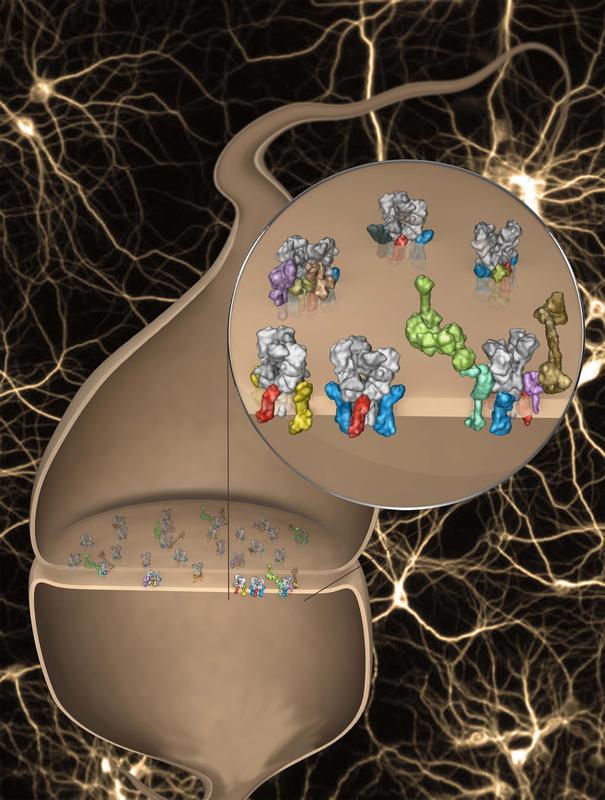Understanding the Components of Memory

The structure determines the function: AMPA receptors in the nerve cells of the brain are composed of a range of more than 30 different proteins. Source: Bernd Fakler
Dr. Uwe Schulte, Dr. Jochen Schwenk, Prof. Dr. Bernd Fakler, and their team have elucidated the enormous spatial and temporal dynamics in protein composition of the AMPA-type glutamate receptors, the most important excitatory neurotransmitter receptors in the brain. These receptors are located in the synapses, the contact points between two nerve cells, where they are responsible for the rapid signal transduction and information processing. The results illustrate that the receptors are far more diverse than previously anticipated and pave the way for research into their functions in the various regions of the brain. The biologists published their findings in the journal Neuron.
The researchers have thus opened up the possibility to investigate the properties and functions of the AMPA receptors in the various regions of the brain at the level of their protein components.
This is of particular significance as the AMPA receptors and their dynamics are regarded as central elements for memory formation. The researchers succeeded in elucidating the subunit structure of the AMPA receptors in various regions of the brain and even in different groups of distinct nerve cells.
It became clear that the receptors exhibit an enormous range of variation in structure and molecular architecture and can evidently be precisely adapted to the function of the nerve cells and brain region in which they are located. In addition, the researchers demonstrated that this diversity in protein composition of the receptors is also exploited during the development of the brain.
In 2012, Fakler’s research team already used novel proteomic technologies to show that AMPA receptors in the brain are assembled from a pool of more than 30 different proteins – whose primary function(s) is are most parts as yet unknown.
In fact in another recent study, also published in Neuron, the researchers demonstrated just how significant these unknown components are or can be: They showed that the cornichon protein dictates the time course of the AMPA receptor-mediated synaptic transmission and thus accounts for the difference between various types of nerve cells in the brain.
Uwe Schulte, Jochen Schwenk, and Bernd Fakler conduct their research at the Institute of Physiology and at the Cluster of Excellence BIOSS Centre for Biological Signalling Studies of the University of Freiburg.
Original publication:
Regional Diversity and Developmental Dynamics of the AMPA-Receptor Proteome in the Mammalian Brain. Schwenk J, Baehrens D, Haupt A, Bildl W, Boudkkazi S, Röper J, Fakler B and Schulte U (2014). Neuron 84, 41–54.
DOI: 10.1016/j.neuron.2014.08.044
Contact:
Prof. Dr. Bernd Fakler
Institute of Physiology / BIOSS Centre for Biological Signalling Studies
University of Freiburg
Phone: +49 (0)761/203-5175
E-Mail: bernd.fakler@physiologie.uni-freiburg.de
Media Contact
More Information:
http://www.pr.uni-freiburg.de/pm/2014/pm.2014-10-06.101-enAll latest news from the category: Life Sciences and Chemistry
Articles and reports from the Life Sciences and chemistry area deal with applied and basic research into modern biology, chemistry and human medicine.
Valuable information can be found on a range of life sciences fields including bacteriology, biochemistry, bionics, bioinformatics, biophysics, biotechnology, genetics, geobotany, human biology, marine biology, microbiology, molecular biology, cellular biology, zoology, bioinorganic chemistry, microchemistry and environmental chemistry.
Newest articles

High-energy-density aqueous battery based on halogen multi-electron transfer
Traditional non-aqueous lithium-ion batteries have a high energy density, but their safety is compromised due to the flammable organic electrolytes they utilize. Aqueous batteries use water as the solvent for…

First-ever combined heart pump and pig kidney transplant
…gives new hope to patient with terminal illness. Surgeons at NYU Langone Health performed the first-ever combined mechanical heart pump and gene-edited pig kidney transplant surgery in a 54-year-old woman…

Biophysics: Testing how well biomarkers work
LMU researchers have developed a method to determine how reliably target proteins can be labeled using super-resolution fluorescence microscopy. Modern microscopy techniques make it possible to examine the inner workings…





















